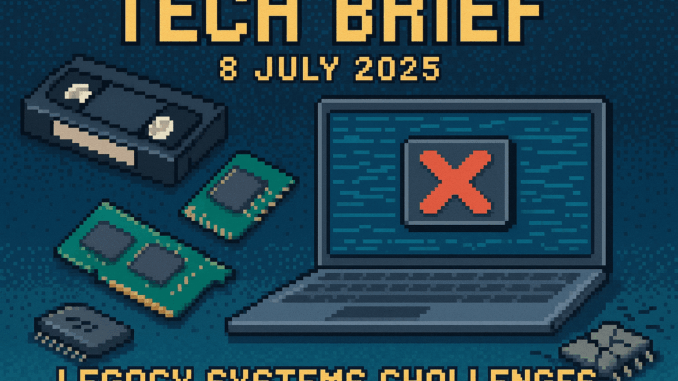
Missed yesterday’s Tech Brief? Catch up here before diving in.
Tech Brief – 8 July 2025 brings us face-to-face with the hidden costs of legacy systems. From police forces wrestling with three-decade-old VHS tapes to Samsung’s memory chips failing modern validation, today’s stories reveal how yesterday’s innovations become tomorrow’s infrastructure headaches. Meanwhile, a ZX Spectrum proves that AI doesn’t always need trillion-parameter models to get the job done.
Today’s Tech Brief Roundup
UK Police Launch £75 Million VHS Digitisation Project
UK police forces are spending £75 million to digitise archived VHS evidence tapes, many over 30 years old. The project aims to preserve deteriorating footage critical for cold cases and legal proceedings. Technical hurdles include magnetic tape degradation and obsolete playback hardware like Panasonic AG-7400 players. Audio synchronisation from multi-camera setups adds another layer of complexity.
For anyone who ever fast-forwarded through a fuzzy tape to find the right scene, you’ll understand the urgency here. The tender documents mandate frame-accurate digitisation at 720p resolution with blockchain timestamps for chain-of-custody verification. Storage requirements hit 5PB across AWS GovCloud infrastructure. Completion is demanded by December 2026.
This isn’t just about preserving old footage. The project exposes how analog-era decisions create expensive digital debt. Every police force that chose VHS over Betamax in the 1980s now faces the same engineering nightmare: rescuing critical data from dying magnetic tape before it’s lost forever.
ZX Spectrum Runs Vector Database in SAP ABAP Port
Developer Marco Fiori successfully ported a vector database written in SAP’s ABAP language to a 48K ZX Spectrum. Following in the footsteps of Sir Clive Sinclair’s vision of accessible computing, the project exploits the Spectrum’s Z80A CPU running at 3.5 MHz to handle small-scale similarity searches for text data. Fiori stripped ABAP’s GUI components, optimising memory usage to fit the 32KB RAM constraint.
Queries reportedly execute at roughly 0.8 seconds per operation via cassette-tape-loaded datasets. That’s 12 operations per minute on hardware that predates most AI researchers by decades. The feat demonstrates minimalist AI implementation. It contrasts sharply with modern GPU clusters that consume megawatts for similar conceptual tasks.
Like typing BASIC programs from Your Computer magazine, this project celebrates hardware constraints over cloud excess. Fiori’s work proves that vector databases don’t require trillion-parameter models. Sometimes the most elegant solutions come from the most limited platforms.
Samsung’s HBM3e Memory Fails Nvidia Approval Amid US Chip Curbs
Samsung’s Q2 profit guidance reveals a 35% drop after Nvidia rejected its HBM3e high-bandwidth memory for AI GPUs. The chips failed thermal validation at 8Gbps speeds. This forced Nvidia to rely on SK Hynix instead. Samsung’s 12nm-class HBM3e reportedly consumes 10% more power than competitors at peak loads. It triggers thermal throttling at 105°C versus the 95°C specification.
Compounding the problem, US export restrictions barred Samsung’s Austin foundry from shipping advanced logic wafers to Chinese clients like SMIC. The dual blow could cost Samsung £960 million annually in lost foundry revenue. This affects 14,000 wafers per month.
This recalls the DRAM shortages of the 1990s, when DIY builders hunted for SIMM modules across computer fairs. Today’s AI boom depends on memory bandwidth more than raw processing power. When Samsung’s chips can’t keep cool under load, entire AI training schedules get delayed. Hardware bottlenecks still throttle software ambitions, no matter how sophisticated the algorithms become.
Autonomous Vehicles Still Rely on Human “Shadow Drivers” in 92% of Tests
Despite promises of fully autonomous fleets by 2025, companies like Cruise and Waymo still employ “shadow drivers” in 92% of test vehicles to override errors. Internal data shows human intervention every 8 miles in urban areas. This primarily occurs for edge cases like construction zones or aggressive pedestrians. California DMV reports reveal AI struggles with spatial reasoning. Vehicles reportedly misinterpret double-parked cars as permanent obstacles 37% of the time.
Safety regulators now demand “human-in-the-loop” protocols for Level 3+ autonomy, delaying commercialisation. Sensor gaps persist: LIDAR misreads reflective surfaces at speeds above 30mph. NYC trials record 12 overrides per hour during peak traffic.
We all remember early GPS systems constantly “recalculating” after missing a turn. Autonomous vehicles face similar challenges, but with life-or-death consequences. The gap between marketing promises and engineering reality remains vast. Federal AV Safety Rules won’t be finalised until Q1 2026, pushing true autonomy further into the future.
From the Wayback Machine
On This Day: 8 July 1995 – Sega Saturn launched across Europe for £399.99, two months ahead of Sony’s PlayStation. The dual-CPU architecture promised raw power but delivered programming nightmares instead. Complex hardware doesn’t guarantee success without developer support. Within two months of PlayStation’s September debut, Sony was outselling Saturn three-to-one in the UK. The Saturn’s technical prowess couldn’t overcome its thin game library and rushed market entry. Sometimes the most elegant solution wins over the most powerful one.
What This Means
Today’s Tech Brief – 8 July 2025 reveals a common thread: yesterday’s cutting-edge becomes today’s maintenance burden. Whether it’s police forces digitising VHS evidence, Samsung’s memory failing modern standards, or autonomous vehicles still needing human oversight, the gap between promise and reality persists. The ZX Spectrum vector database proves that innovation often comes from constraint, not excess. In a world obsessed with bigger, faster, and more powerful, sometimes the most impressive feat is making old hardware do new tricks.
Choose your legacy systems wisely—you’ll be supporting them longer than you think.

Leave a Reply